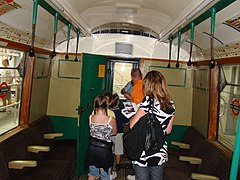

In urban public transport, provision is made for standing passengers, often called straphangers [1] [2] [3] [4] or standees, [5] to rationalize operation and to provide extra capacity during rush hour.
Contents
On crowded rapid transit urban lines, while most travelers may be seated during off-peak services, only a limited proportion will be seated during the peak services. The longer the journey, the less willing passengers are to stand. On intercity rail or coach services, the willingness among passengers to stand is often low, or it may even be prohibited, with reserved seating to ensure that all passengers can be seated. Examples of modes of public transport where standing is always prohibited in the vehicle are school buses, gondola lifts, and amusement park railways.
In aviation, safety measures require all passengers and crew to be seated with their seat belts fastened during taxiing, take-off, landing, and turbulence, so airlines do not allow passengers to travel without a seat. However, in 2010, Ryanair, a low-cost airline proposed a "vertical seat" design for use by standing passengers on its aircraft. [6]












